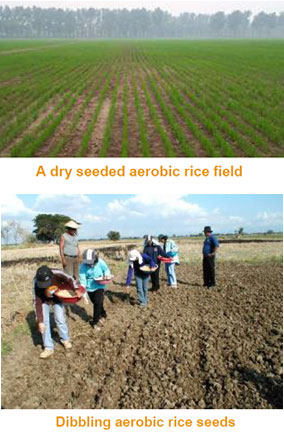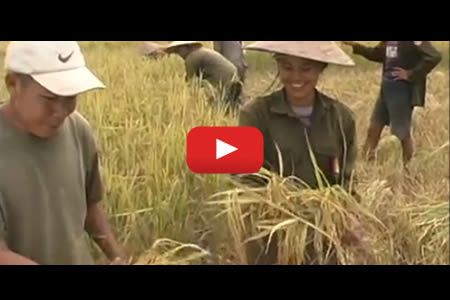Aerobic rice
What is aerobic rice?

Aerobic rice is a production system in which especially developed “aerobic rice” varieties are grown in well-drained, non-puddled, and nonsaturated soils. With a good management, the system aims for yields of at least 4-6 tons per hectare.
Target area
Aerobic rice can be found, or can be a suitable technology, in the following areas:
- “Favorable uplands”: these are areas where the land is flat, and where rainfall with or without supplemental irrigation is sufficient to frequently bring the soil water content close to field capacity, and where farmers have access to external inputs such as fertilizers.
- Fields on upper slopes or terraces in undulating, rainfed lowlands: quite often, soils in these areas are relatively coarse-textured and well-drained, so that ponding of water occurs only briefly or not at all during the growing season.
- Water-short irrigated lowlands: these are areas where farmers do not have access to sufficient water anymore to keep rice fields flooded for a substantial period of time.
Management
The usual establishment method is dry direct seeding. Aerobic rice also allows practices of conservation agriculture as used in upland crops, such as mulching and minimum tillage.
 Aerobic rice can be rainfed or irrigated. Irrigation can be applied through flash-flooding, furrow irrigation (or raised beds), or sprinklers.
Aerobic rice can be rainfed or irrigated. Irrigation can be applied through flash-flooding, furrow irrigation (or raised beds), or sprinklers.
Unlike flooded rice, irrigation—when applied—is not used to flood the soil but to just bring the soil water content in the root zone up to field capacity.
Site-specific nutrient management (SSNM; http://irri.org/ssnm/) can be used to determine the optimal management of fertilizers. In the absence of knowledge on SSNM, 70−90 kg N/ha could be a useful starting point to obtain a yield of 4−6 t/ha. The first split can best be given 10−12 days after emergence, the second at active tillering, and the third at panicle initiation. The application of Phosphorus fertilizer can be more critical to aerobic rice than to flooded rice.
Rice fields that are not permanently flooded tend to experience high growth and more species of weed. Appropriate herbicide use and additional manual or mechanical weeding in the early phase of crop growth, are therefore needed to control weeds.
Soil-borne pests and diseases such as nematodes, root aphids, and fungi are known to occur more in aerobic rice than in flooded rice, especially in the tropics. It is recommended to grow aerobic rice in rotation with upland crops suitable in the area.
Find out more about aerobic rice:
Download the book “Water management in irrigated rice - Coping with water scarcity” at: http://books.irri.org/9789712202193_content.pdf







